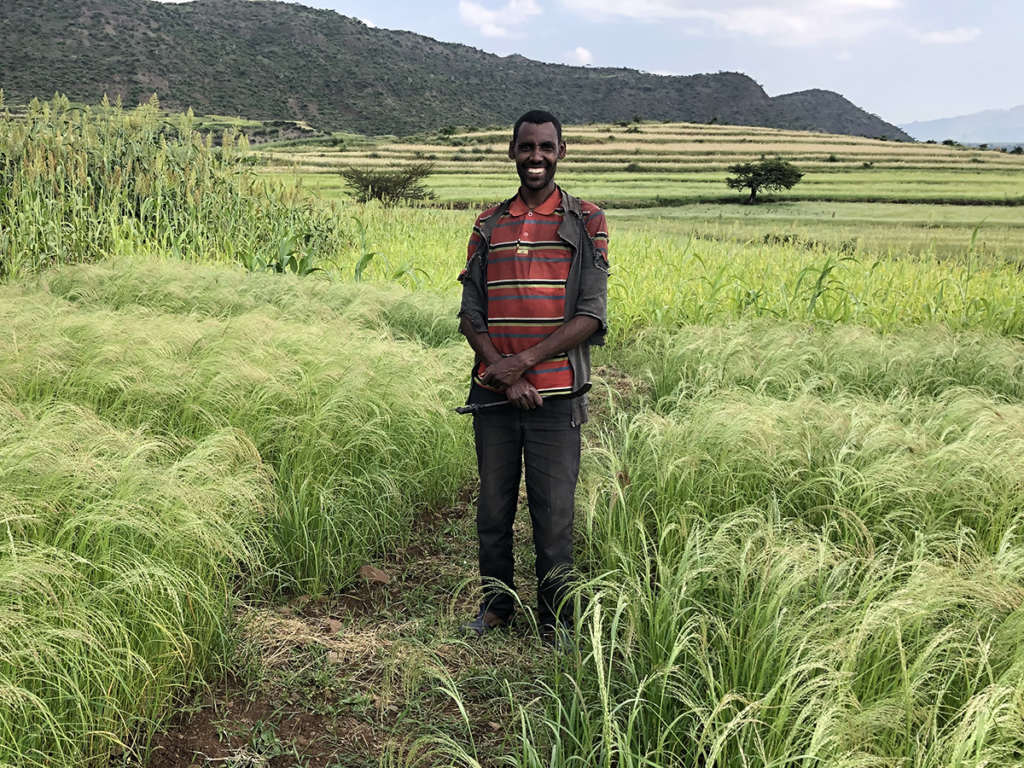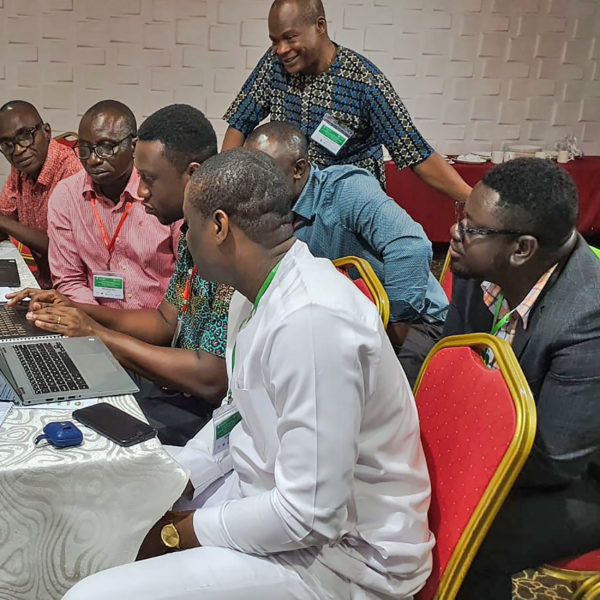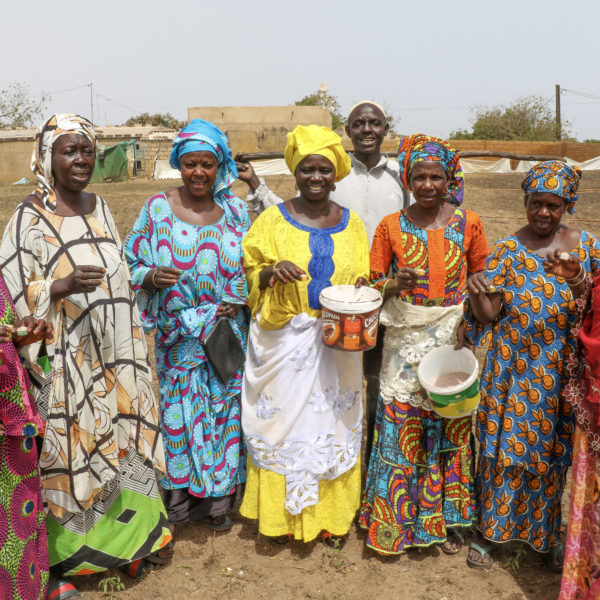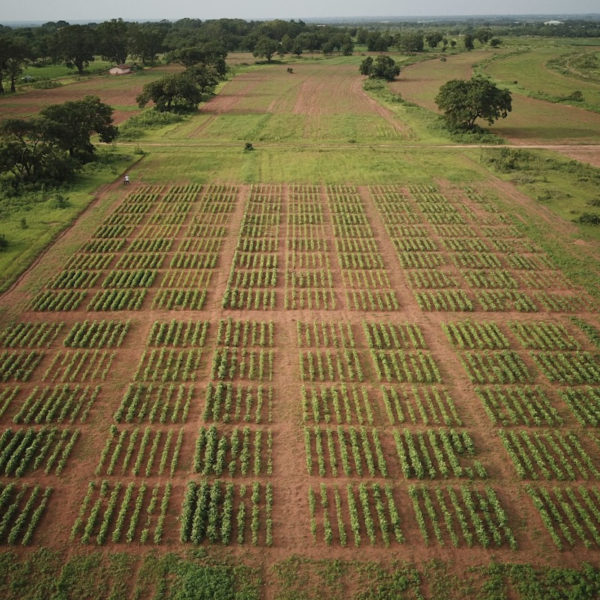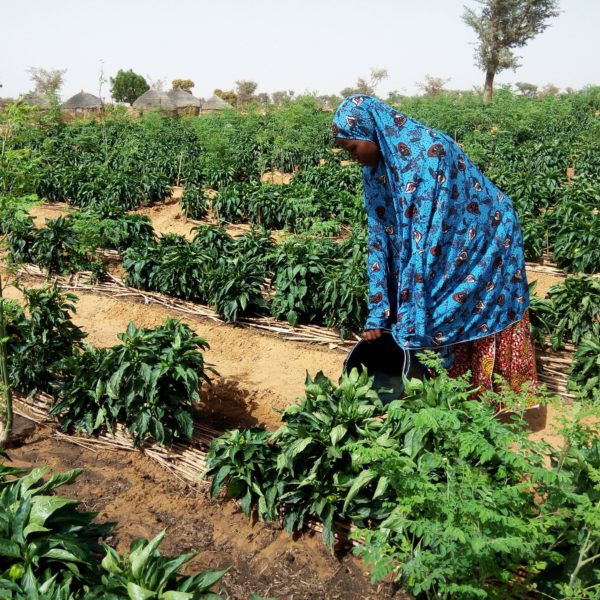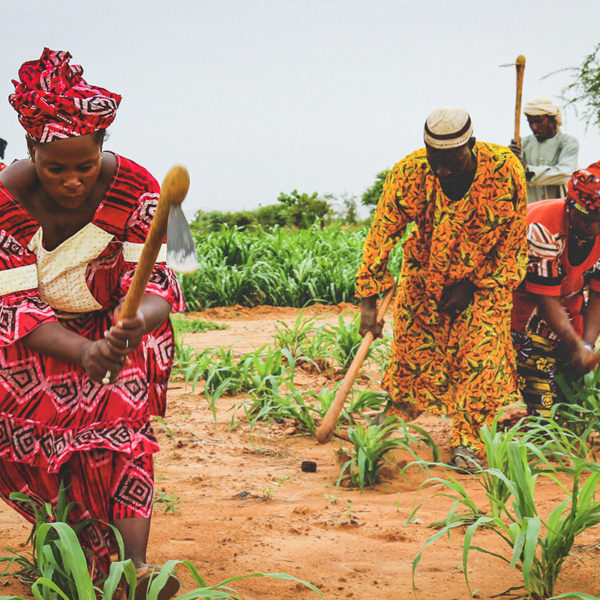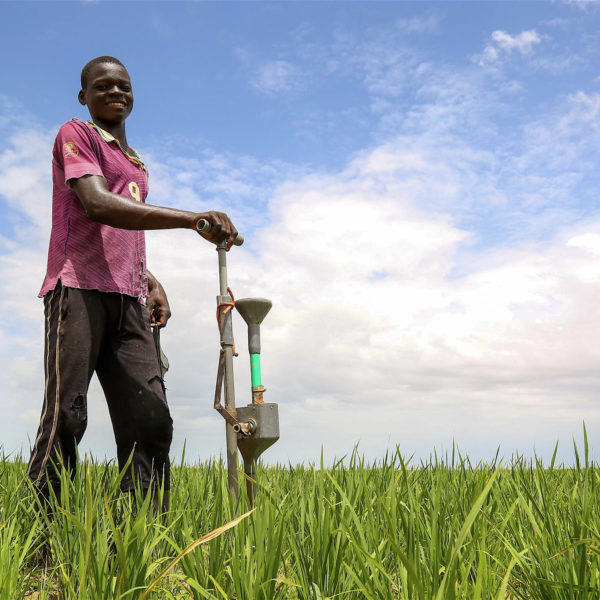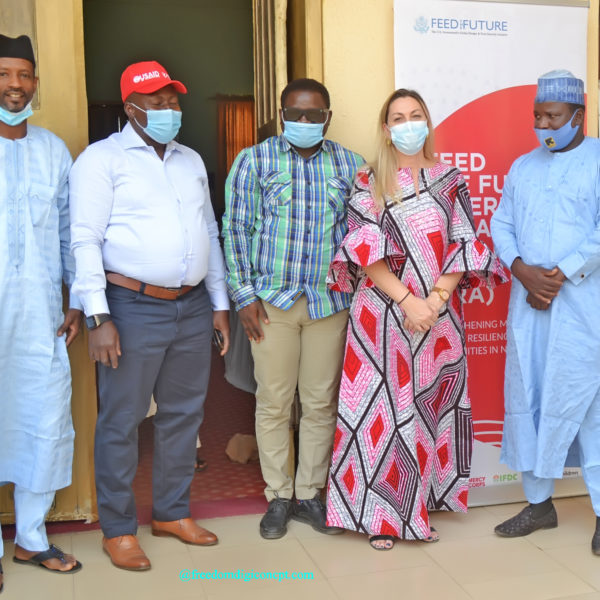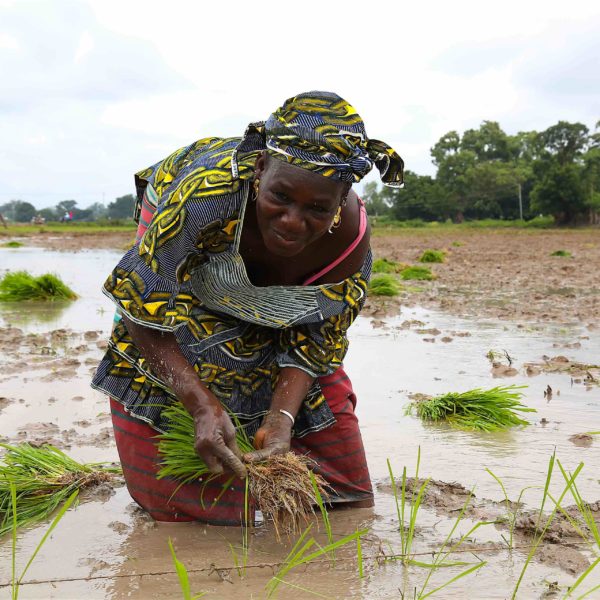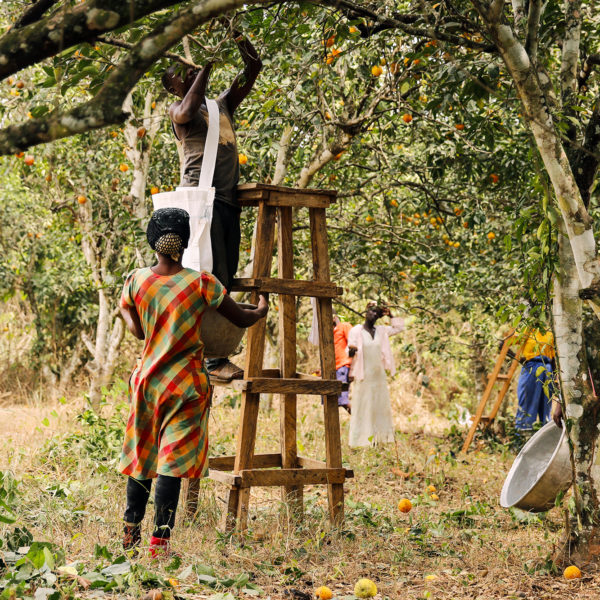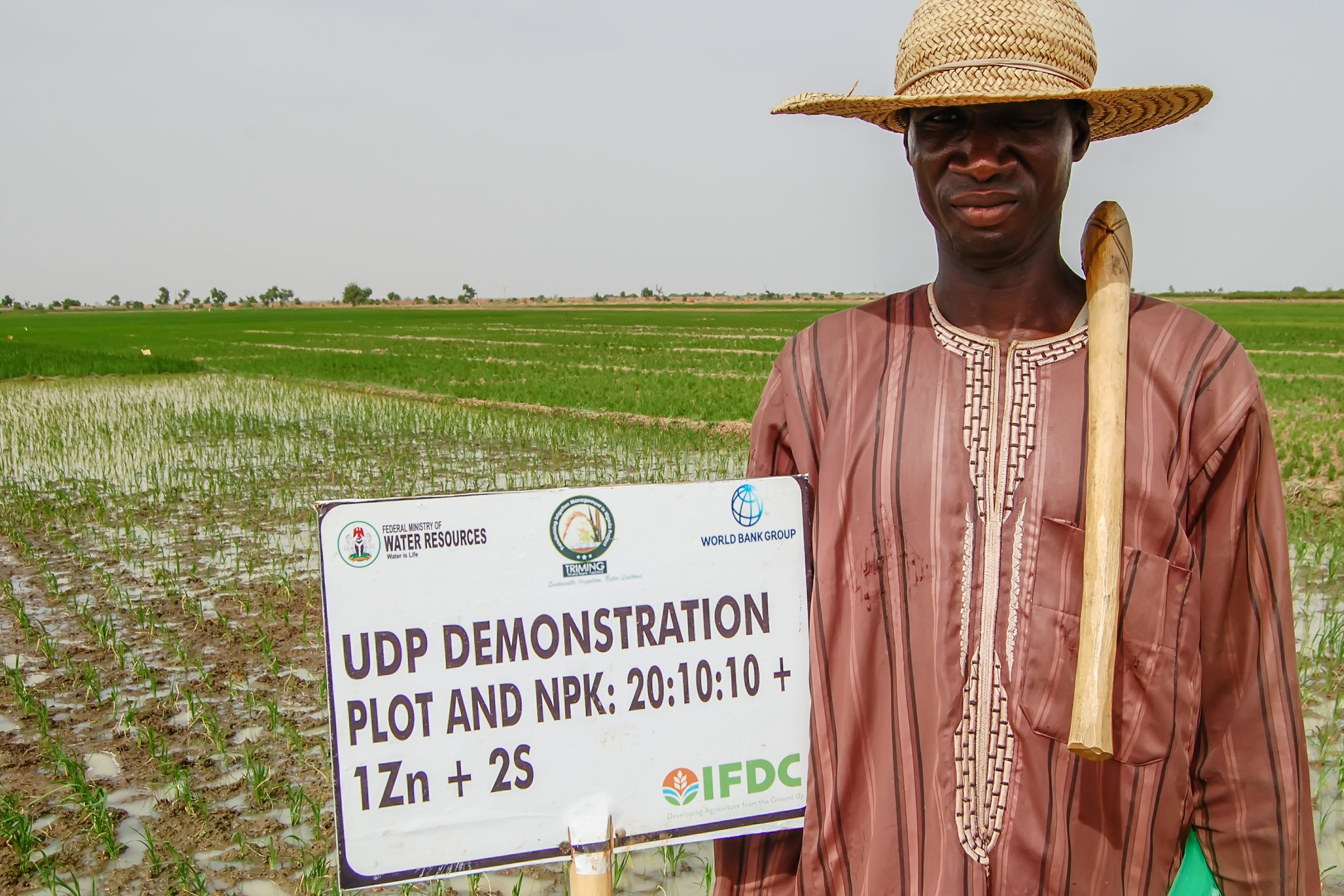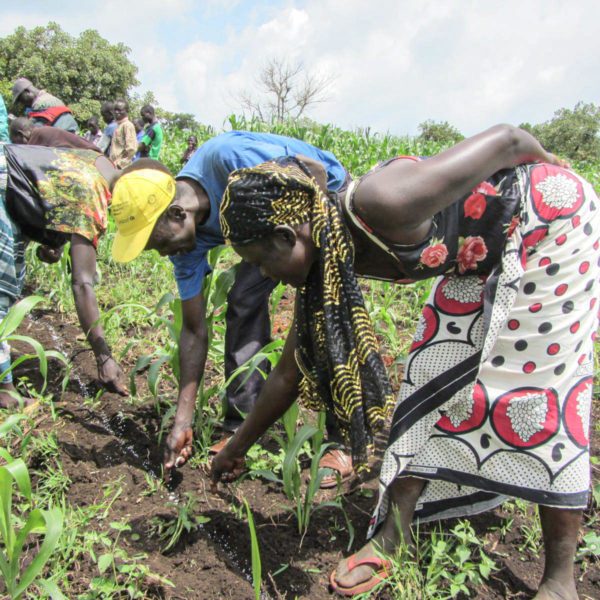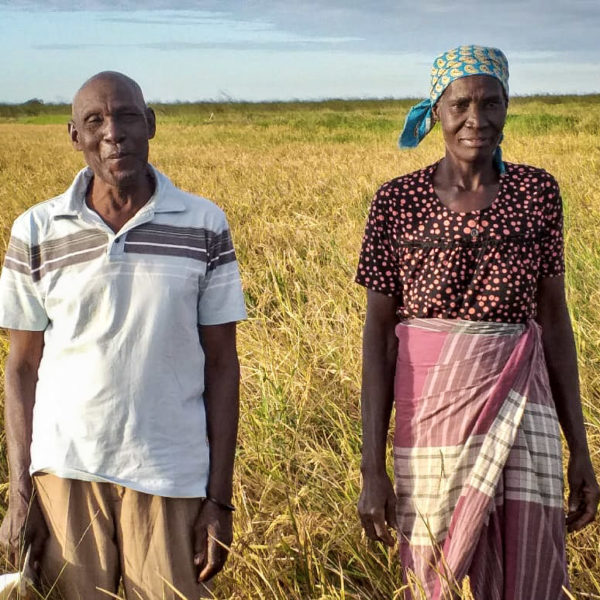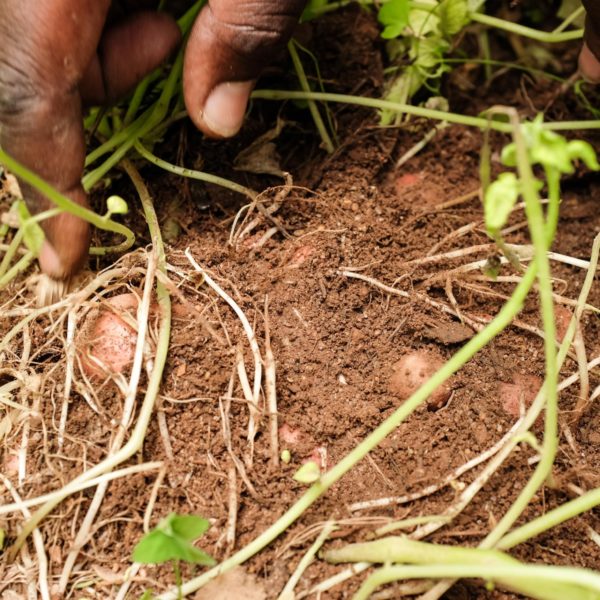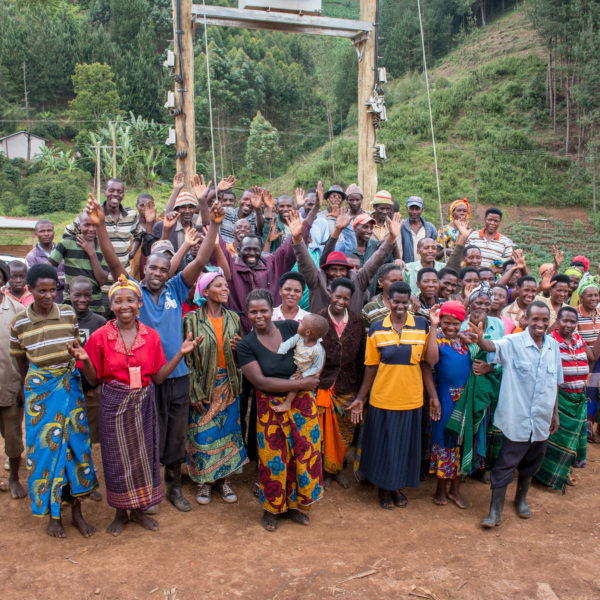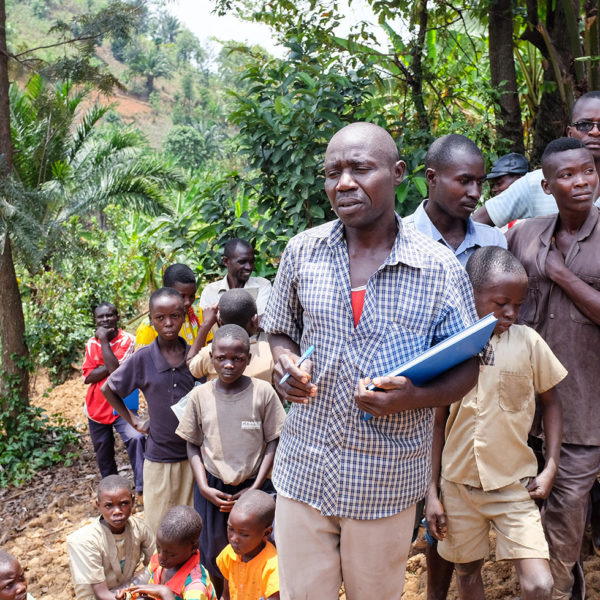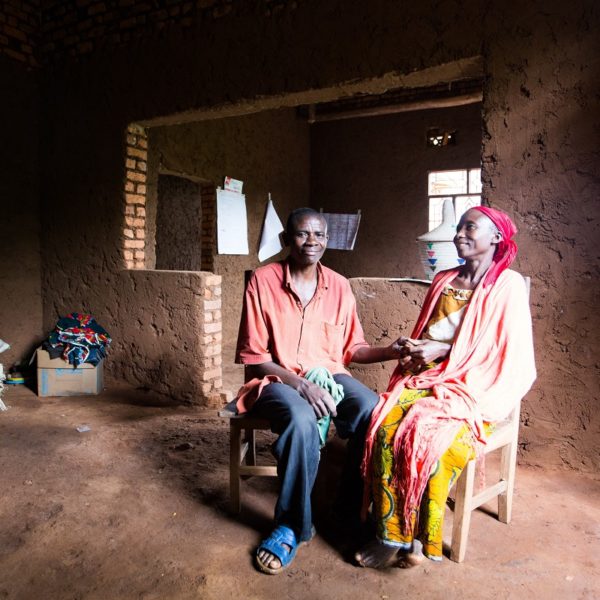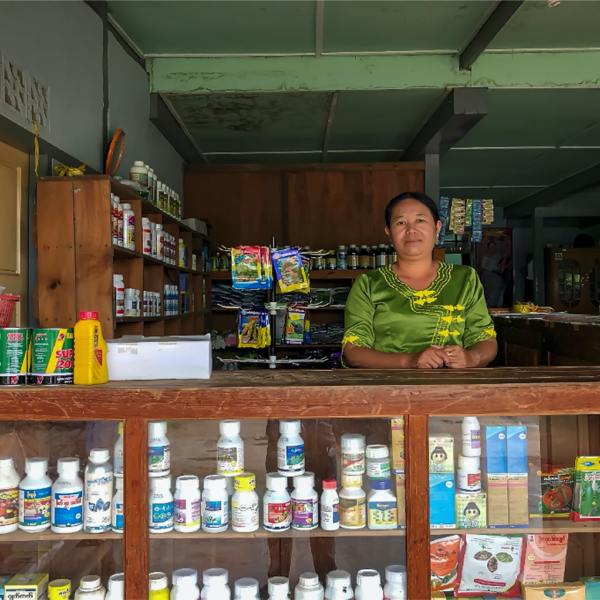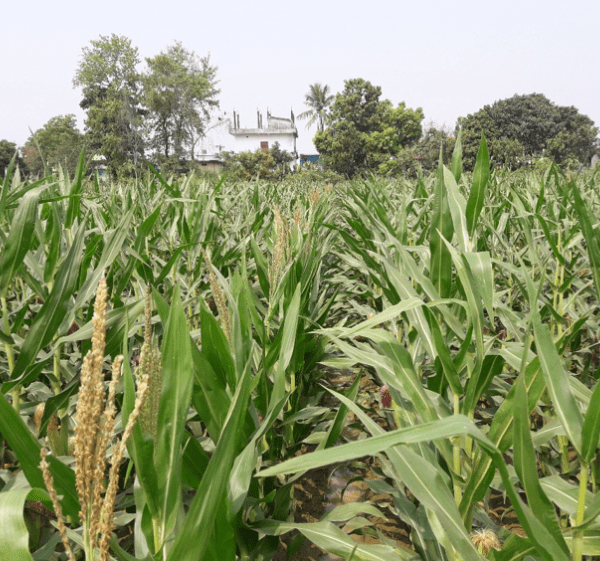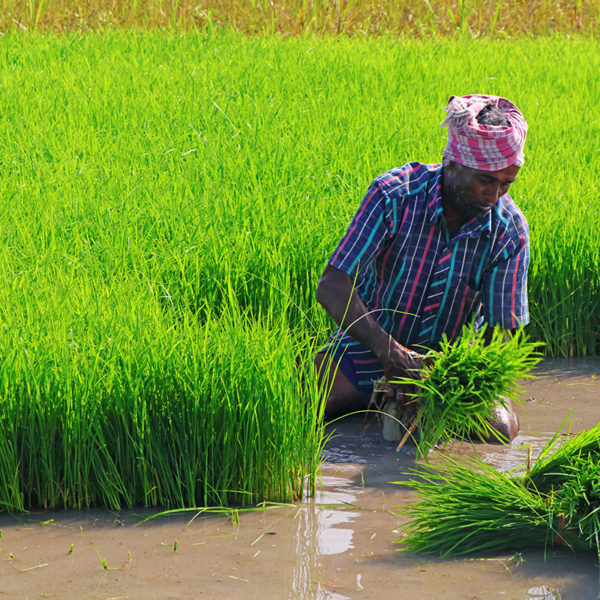
Download the PDF
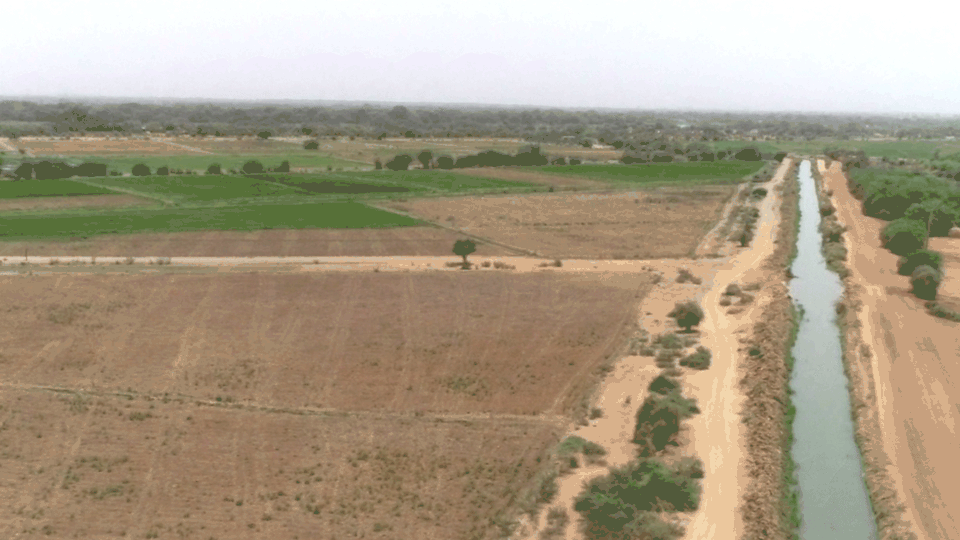
Letter from IFDC’s Leadership
Strength in the Face of Adversity.
The shocks of 2020 are already being written into the history books. Events such as the COVID-19 pandemic are once in a lifetime, and as such, we only have one chance to respond to an event for which none of us was prepared.
IFDC’s resilient staff overcame the many obstacles presented by the pandemic. More than 400,000 smallholder farmers in nearly 30 countries adopted yield- and income-improving agricultural technologies, transforming more than 190,000 hectares of farmland. More than 14,000 demonstration plots exemplified proven technologies to these farmers, letting them see with their own eyes the benefits of adoption, and over 5,000 outreach activities sought out agricultural entrepreneurs who want to make a difference. Training and capacity-building efforts reached 260,000 farmers, 46% of whom were women, which is key to achieving Sustainable Development Goal (SDG) 2, Zero Hunger. Finally, a remarkable 838 public-private partnerships were formed – allowing IFDC to amplify both the quality and quantity of its efforts. Our research team continues to make strides in the area of soil health, and as a result, more than 50 scientific papers and reports were published by IFDC researchers in 2020.
Adoption of the agricultural products and practices pioneered and promoted by IFDC has changed the lives of millions of smallholders around the world. In 2020 the Africa Food Prize foundation evidenced this fact in the selection of Dr. André Bationo, chief of party for the Smallholder Agricultural Productivity Enhancement Program (SAPEP) in West Africa, who has been working to improve the lives of farmers for four decades. Bationo was recognized for his trailblazing work in microdosing, a climate-smart, yield-enhancing, and income-improving fertilizer application method, and warrantage, a credit system that helps farmers store and sell crops for higher pricing.
We are also honored that the 2020 World Food Prize laureate, Dr. Rattan Lal, agreed to join our board of directors. Lal’s work on developing and mainstreaming a soil-centric approach to increasing food production has already been recognized by many other international accolades, and we are excited to have his expertise assist in guiding the organization.
Last year, we wrote that we were “navigating uncharted waters,” and while there still seems to be some way to go, we have learned a lot and are confidently moving toward our vision of healthier soils and plants for a food-secure and environmentally sustainable world.
Let the history books remember not only the obstacles we faced, but the courage with which we faced them and the successes we achieved despite them.


Our Results in 2020
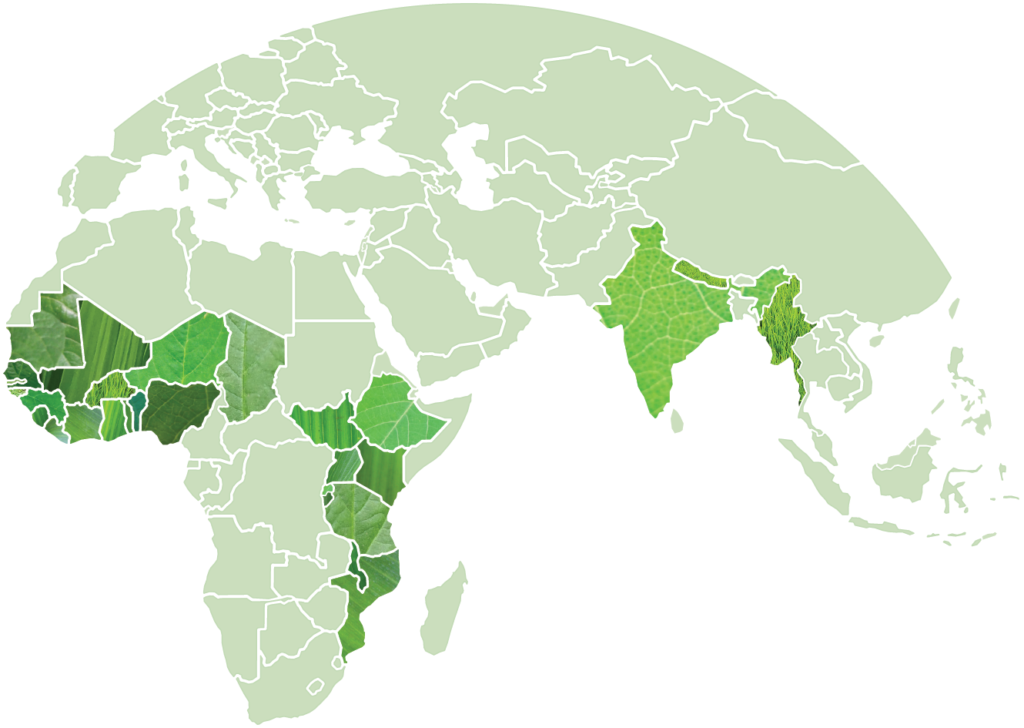
Benin* | Burkina Faso* | Burundi* | Cabo Verde | Cameroon | Chad | Côte d’Ivoire* | Ethiopia* | Gambia | Ghana | Guinea | Guinea-Bissau | India* | Kenya* | Liberia | Malawi | Mali* | Mauritania | Mozambique* | Myanmar* | Nepal | Niger* | Nigeria* | Rwanda | Senegal* | Sierra Leone | South Sudan | Tanzania | Togo | Uganda*
*Indicates presence of a country office/representative.
Vision
Healthier soils and plants for a food-secure and environmentally sustainable world.
Mission
Bring together innovative research, market expertise, and strategic public and private sector partners to identify and scale sustainable solutions for soil and plant nutrition that benefit farmers, entrepreneurs, and the environment.
Organizational Indicator Results for 2020
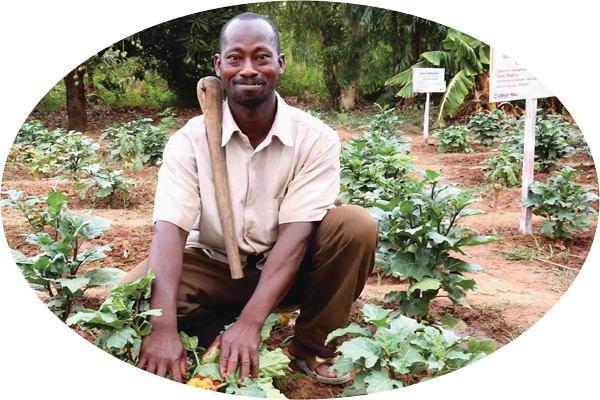
14,501
DEMONSTRATION PLOTS ESTABLISHED
Management practices and/or technologies tested in farmer fields for dissemination
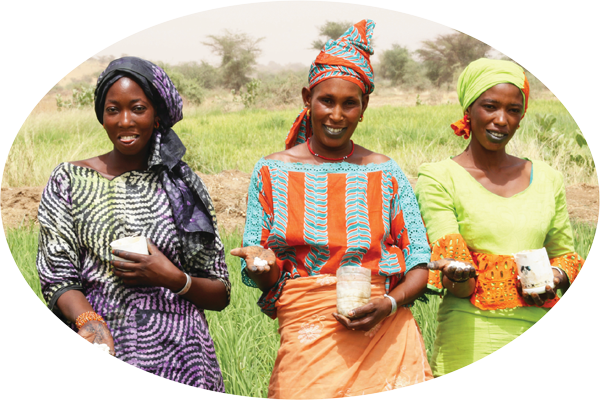
267,023
FARMERS TRAINED (46% WOMEN)
Direct farmer participants in short-term
capacity building on management practices and/or technologies

416,522
FARMERS APPLYING GOOD AGRICULTURAL PRACTICES
Farmers who have applied improved farm management practices and/or technologies
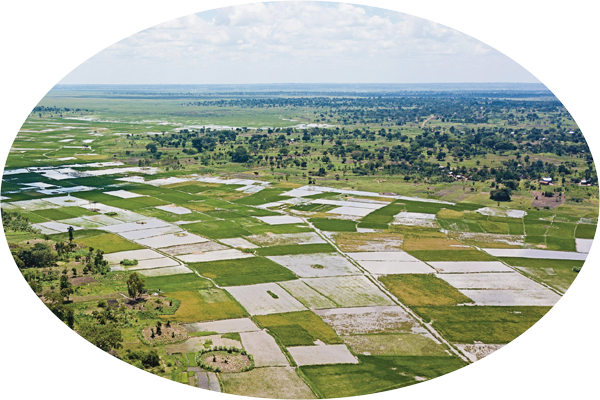
193,768
AREA UNDER GOOD AGRICULTURAL PRACTICES
Hectares under improved management practices and/or technologies (managed or cultivated by farmer partners)
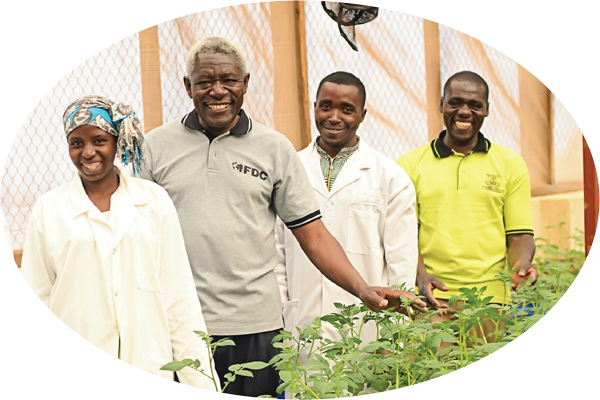
838
PUBLIC-PRIVATE PARTNERSHIPS
Agreements between public and private firms/actors and research, academic, civil society, and stakeholder associations
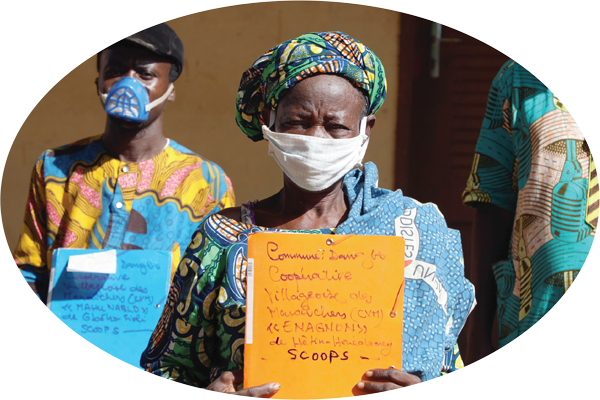
5,135
OUTREACH ACTIVITIES
Dissemination activities: workshops, forums, stakeholder consultations, publications,
and print, radio, and television media
New Organizational Indicator Results for 2020
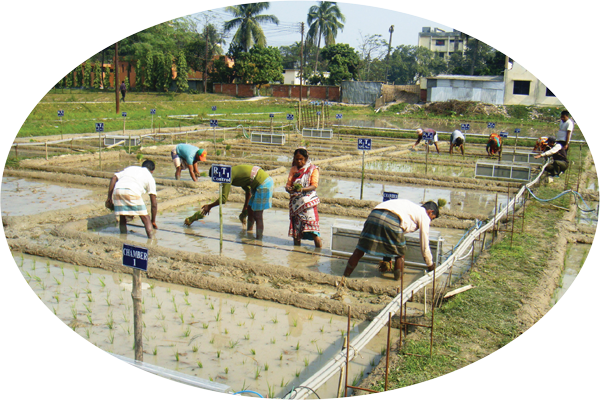
41,389
CLIMATE-ADAPTIVE TECHNOLOGIES
Area (ha) under improved technologies that promote improved climate risk reduction (mitigation/adaptation) and/or natural resource management (NRM) practices
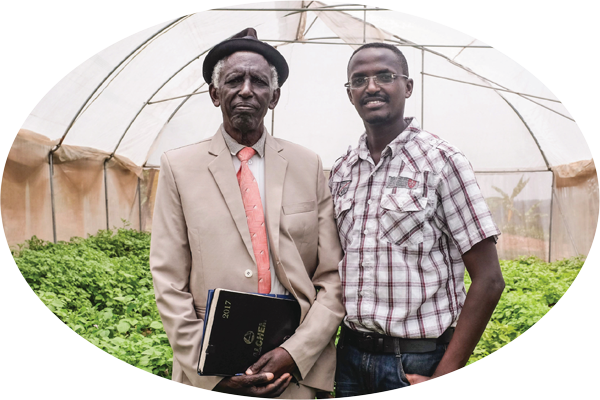
5,738
NEW JOBS CREATED
Jobs created resulting from agri-business interventions during 2020
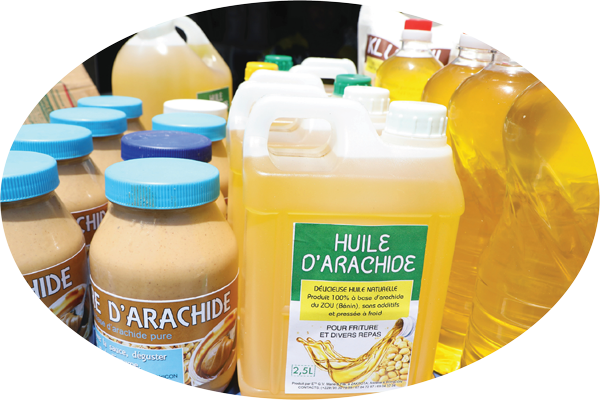
4,177
PRIVATE AGRI-ENTERPRISES
# of private sector (SMEs, MSMEs) firms that have benefited and improved as a result of interventions
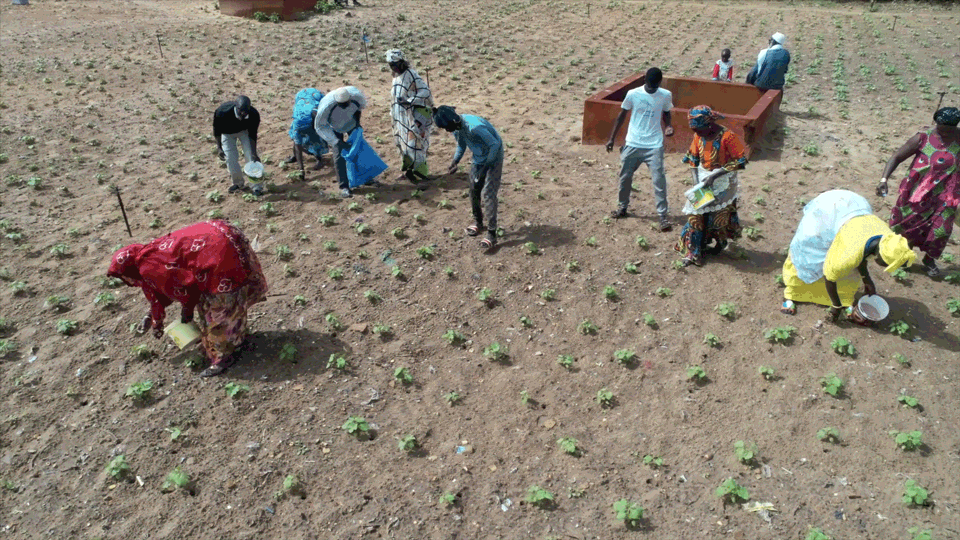
Research Highlights
IFDC Research plays a unique intermediary role by transforming innovative fertilizer products and soil fertility management technologies into adaptable and scalable production technologies. We undertake applied research and implementation, involving scientific discovery, development, and testing of advanced fertilizers and related soil fertility management technologies; design of fertilizer manufacturing and quality control processes; market system development; and applied policy and regulatory analysis. The overall goal of IFDC research is to significantly boost the production of higher quality food, using less land and water; improve the climate resilience of farming systems; and reduce adverse environmental impacts associated with agriculture.
Research outputs generated across focus areas (2018-20)
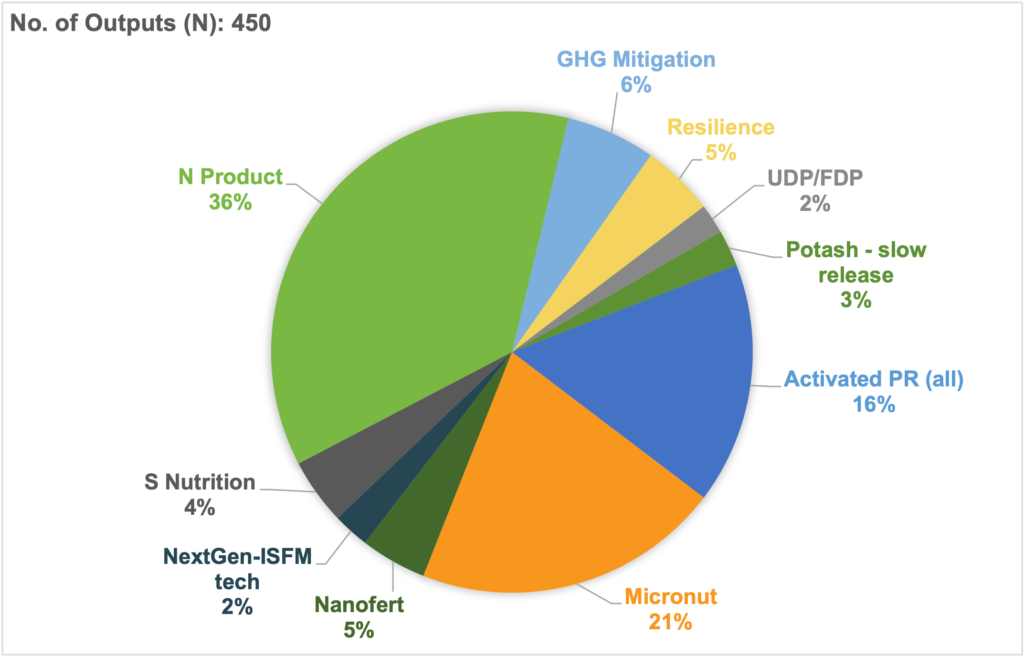
| Technologies/Practices | # of outputs* | Phase 3 | Phase 4 |
|---|---|---|---|
| Potash – slow release | 11 | 2 | |
| Activated PR (all) | 73 | 20 | 1 |
| Micronutrients | 93 | 20 | |
| Nanofertilizers | 20 | ||
| NextGen-ISFM tech | 11 | ||
| S Nutrition | 20 | ||
| N Product | 164 | 2 | |
| GHG Mitigation | 27 | 2 | |
| Resilience | 22 | 2 | 2 |
| UDP/FDP | 9 | 2 | 2 |
*Outputs include individual protocols, product formulations, fertilizer recommendations across different crops, ecologies and countries under research.
Phases 3 and 4 are advanced stages of research:
Phase 3: Made Available for Uptake (formal recommendations ready for dissemination to farmers; can use legally);
Phase 4: Demonstrated Uptake by Public and/or by Private Sector Org (not by individual farmers or by donor uptake)
Balanced Fertilization
Balanced fertilization is the key to sustained high productivity, increased nutrient use efficiency, reduced losses, and improved soil health. Balanced nutrition can be achieved through fertilizers, organic amendments, biofertilizers, and integrated use of these. To facilitate balanced fertilization, IFDC has developed a SMaRT framework that incorporates Soil testing, Mapping, Recommendations development, and Transfer to farmers.
Since 2017, comprehensive soil testing and a series of nutrient omission trials have been conducted in Ghana with support through the USAID RFS-SFT program. These trials demonstrated that sulfur (S), zinc (Zn), and boron (B) are often required to enhance crop productivity. For maize, grain yield increased at least 60% compared to the recommended NPK fertilization with addition of these secondary and micronutrients. Based on these results, balanced fertilizer recommendations were developed for maize and soybean on soils ranging from near neutral to acidic. As evident from the figure, the “best bet” rate for S, Zn, and B on strongly acidic soil is the “low rate,” which is only 50% of the “best bet” recommendation

For near-neutral soils (A), the “best bet” application rate of S, Zn, and B outperformed other rates, while in moderately acid (B) and strongly acid (C) soils, the trials indicated that the low rate of application would be recommended.
To ensure increased productivity in the soils of most parts of northern Ghana and realize the full benefits of the investments in fertilizers the government of Ghana, through the Ministry of Food and Agriculture, is now introducing NPK fertilizers that contain the nutrients we have identified as limiting (B, S, and Zn) to farmers across the country, particularly in the five northern regions.
In Rwanda two seasons of balanced fertilization trials with focus on fertilizer formulations were completed for six crops: Irish potato, rice, maize, wheat, beans (both climbing and bush) and soybean. The evaluations compared several “best bet” options containing various ratios of NPK combined with S, Zn, B and/or copper (Cu) with blanket NPK fertilizer recommendations used in Rwanda, either diammonium phosphate (DAP) or 17-17-17. The formulations were evaluated in various provinces with distinct soil characteristics to target optimal formulations. Average yield increases, which varied per province, were as follows: potato, 4-7 metric tons per hectare (mt/ha); rice, 1.2-2.4 mt/ha; maize, 0-7-3.2 mt/ha; wheat, 1.1-2.0 mt/ha; bush beans, 0.3-1.0 mt/ha; climbing beans, 0.7-1.6 mt/ha; and soybean, 0.8-1.0 mt/ha. Trial work focused on reducing micronutrient concentrations in formulations to lower costs without compromising yield. Based on these trials, eight formulations have the requisite two season of data for release in Rwanda. This research was funded by OCP in anticipation of these blends being produced in the Rwanda Fertilizer Company’s blending facility in Rwanda.
SOILS Consortium
SOILS Consortium research efforts in Ethiopia and Niger have made substantial progress in 2020 despite COVID-19. A unified fertilizer trial protocol for targeting fertilizer source and rate protocols in Ethiopia was jointly developed by IFDC, ICRISAT, and EIAR, and 362 field trials were implemented for teff (183), wheat (119), and sorghum (60) across Amhara, Oromia, SNNPR, and Tigray regions. The goal of this activity is to produce a model for prediction of responses to different nutrient combinations and rates, with emphasis on potassium (K), S, Zn, and B, that improves upon the current fertilizer targeting by using soil critical values only. The model considers multiple variables, including soil analysis values, soil properties such as soil pH, soil texture, and soil organic carbon, soil classification, landscape position, crop, weather (rainfall), and agroecology and link to crop response. The intended use of the model is within a dedicated decision support tool and within the Ethiopian Soil Information System (EthioSIS). Crops were harvested from 290 sites, excluding Tigray.
Initial results indicate:
- Yields of wheat and teff increased significantly, more than 300% vs. control, up to 8% relative to the NP treatment only, and over 25% compared to treatment with half of all the nutrients (50% of all nutrients + K) with application of 150% of K.
- Sorghum yield increments of about 37% and 21% were achieved at foot slope position compared to hill and mid-slope positions, respectively.
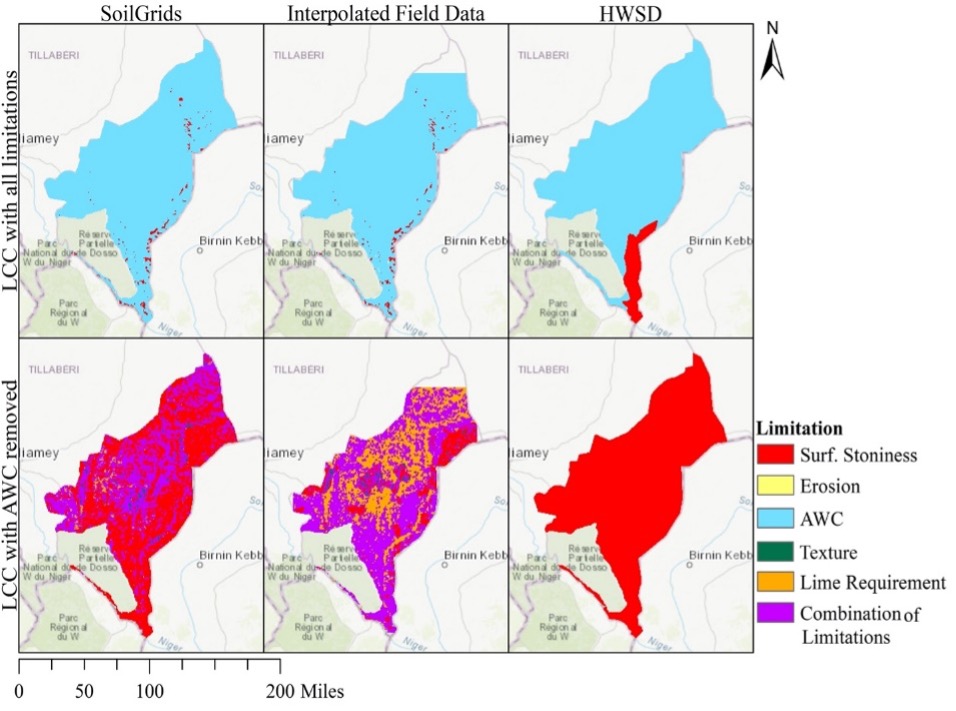
SOILS Consortium led efforts in Niger to “Enhance Resilience to Food Insecurity and Conflict through Land-Use Planning, Soil Rehabilitation, and Capacity Building” resulted in maps for Dossa Region, Niger to provide land capability classifications (LCC) to guide commune- and/or individual-level decision making on about appropriate land management including appropriate livestock, crop, fodder, rangeland, conservation, or other land management practices suitable for intensification. LCC is a land potential evaluation system that classifies land based on its limitations for agriculture, including factors affecting both potential productivity and degradation risk.
The LCC work in Niger is led by the University of Colorado Boulder (UCB) using smartphone-enabled LandPKS to gather site-specific information on soils and physical land properties, such as slope and texture. In fall 2019, the UCB team created an initial map product for the region and, in 2020, using field data collected by IFDC, refined the map, added an assessment of soil nutrient status, and tested whether remote sensing data could add additional value to the map products. The results of this analysis have been published in the journal Land and the map products have been shared with stakeholders, including the Millennium Challenge Corporation, for feedback or potential use. The figure to the right illustrates a comparison of the spatial details of LCC using the field data from this study in comparison to the SoilGrids digital soil product and the Harmonized World Soil Database (HWSD) map from the Food and Agriculture Organization of the United Nations (FAO). This comparison is a key step toward a more nuanced understanding of how best to scale the activities in Dossa to a broader regional level using a mix of field data and global soil data products.
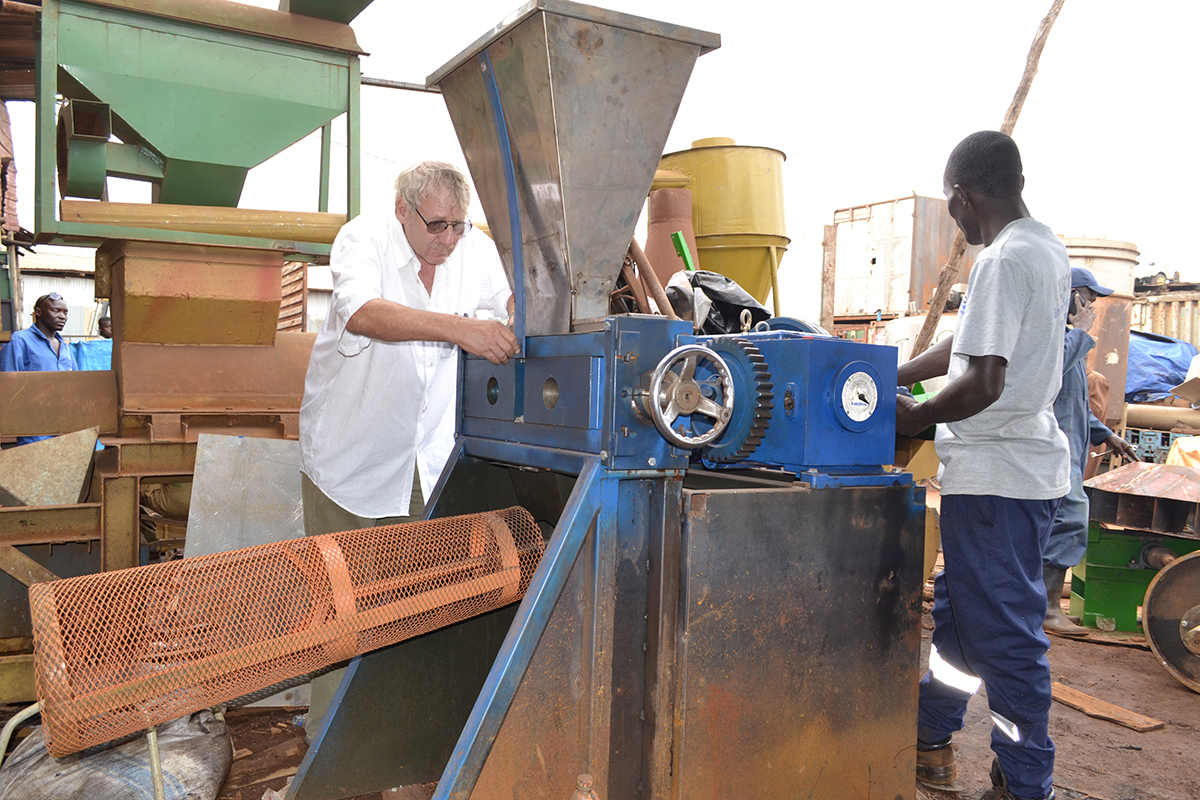
Development of a High-Capacity Briquetting Machine for Sub-Saharan Africa
The most limiting factor for adoption of fertilizer deep placement in SSA and elsewhere is assured supply and access to fertilizer briquettes. To mitigate this constraint, development of a high-capacity briquetting machine began in Uganda in 2019 with the assistance of the USAID-funded RFS-SFT project and is near completion. This machine is anticipated to have a production rate of 5 mt or more per hour. This high-capacity model will be a key component of a briquette production and distribution model better suited to sub-Saharan Africa . Unlike Bangladesh, rice is grown in dispersed locations in sub-Saharan Africa, so it is logistically better to place a high-capacity briquetting machine at a urea distribution point, where briquettes can be distributed to diverse rice programs as well as cooperatives. This differs from the Bangladeshi model in which briquettes are fabricated at the point of sale of urea using a small briquetting machine that can run intermittently at a capacity of less than 0.5 mt per hour. The high-capacity machine has an adjustable feed and speed control to suit various characteristics of urea (prilled or granular of varying moisture concentrations) and can be equipped with a cooled motor or a diesel-powered engine to permit continuous operation.
Economics and Policies for Change
During 2020, IFDC’s economics and policy work focused primarily on research and advocacy efforts through focused surveys and consultations among stakeholders. The Kenya Fertilizer Platform (KeFERT), initiated in 2018 through IFDC’s efforts, continued facilitating fertilizer forums of interest to the stakeholders with the Ministry of Agriculture during 2020 despite COVID-19, conducted a webinar on Kenya soil mapping, and disseminated the new Kenya soil map site.
To support the fertilizer sector reform plan (FSRP) process in Niger, the five key new fertilizer regulations were disseminated on a large scale across the country to the primary stakeholders (fertilizer suppliers, crop producers, and agricultural technicians) in the domestic fertilizer value chain. This activity sought to raise awareness among key stakeholders on the new legal framework for fertilizer and has involved the distribution of outreach materials (hard copies of the regulations in local languages through mass media, face-to-face meetings, and key informant sessions). Of the five regulations passed, fertilizer actors placed more value on those related to licensing, sales, and sanctions.
In 2020, a field-based economic study was conducted among farmers, input retailers, and extension agents to understand their knowledge and perceptions of micronutrient fertilizer use (Zn, B, and manganese [Mn]) and their access in rice farming in Bangladesh. The private sector is the sole source of supplier of micronutrient fertilizers, technologies, and knowledge. Preliminary survey results from input retailers (45) and agricultural extension officers (15) in rice-growing southwestern Bangladesh indicate the need for close monitoring of micronutrient fertilizer quality available in the market, with a multiplicity of brands being imported and supplied by private firms for consumption.
Fertilizer Engineering, Production, and Research
IFDC’s engineering and pilot plant services division helps fertilizer producers solve production problems.
Despite the challenges caused by the COVID-19 pandemic, such as travel restrictions and working from home for some time, the pilot plant completed five projects for private sector partners. The team also provided technical assistance in troubleshooting operational problems in a foreign customer’s full-scale plant. An engineering package based on pilot plant operations conducted at IFDC was completed and was used as the basis for a detailed design of a full-scale plant to be constructed overseas. Research support was provided for activation of phosphate rock for field trials in sub-Saharan Africa. The pilot plant also underwent a major maintenance and refurbishing during the year.
Research on fertilizer formulations, properties, technical feasibility, and overall market feasibility of products is made possible through an interdisciplinary team of engineers, technicians, scientists, and economists.

Pilot Plants and Laboratories
- Fully continuous fertilizer granulation plants.
- Phosphoric acid plants.
- Laboratories for chemical and physical characterizations of fertilizer materials.
- Laboratories for fertilizer compaction/granulation, briquetting, pelletizing, and tableting.
North and West Africa
Benin | Burkina Faso | Cabo Verde | Cameroon | Chad | Côte d’Ivoire | Gambia | Ghana | Guinea
Guinea-Bissau | Liberia | Mali | Mauritania | Niger | Nigeria |Senegal | Sierra Leone | Togo
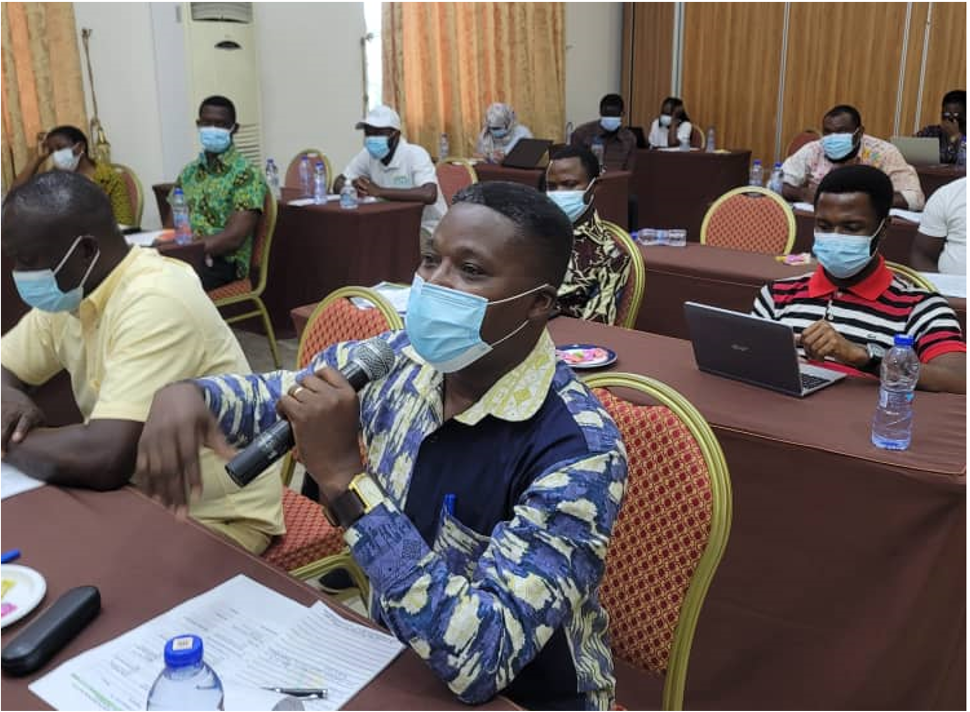
FERARI supports Ghana to Establish a Fertilizer Stakeholder Platform
IFDC’s Fertilizer Research and Responsible Implementation (FERARI) project is collaborating with the government of Ghana’s Fertilizer Expansion Program to establish the Ghana Fertilizer Platform (GFP) for the sustainable development of the fertilizer sector for food and nutrition security. Fertilizer stakeholders in Ghana welcome a multi-stakeholder GFP.
FERARI activities run from 2019 to 2024 and are co-funded by OCP, Mohammed VI Polytechnic University (UM6P), IFDC, and other involved institutions. Partners also include Wageningen University and Research (WUR), University of Liège (ULiège), universities and research institutes in Ghana, including University of Ghana (UG), Kwame Nkrumah University of Science and Technology (KNUST), and the University for Development Studies (UDS).
North and West Africa Project Updates
Swipe or use arrows to navigate.
East and Southern Africa
Burundi | Ethiopia | Kenya | Malawi | Mozambique | Rwanda | South Sudan | Tanzania | Uganda

Boosting Yields through Access to Finance
The Resilient Efficient Agribusiness Chains in Uganda (REACH-Uganda) project connected with the Geshaho Farmers’ Group in Butaleja and linked them with the Microfinance Support Centre (MSC), which provides farmers access to agricultural loans and group loans with low interest rates.
To Jamila Nabirye and the 40 members of her group, this was a great relief and a turning point.
East and Southern Africa Project Updates
Swipe or use arrows to navigate.
Asia
India | Myanmar | Nepal

Success Story: En Route to Improved Agronomic Literacy
The use of balanced fertilizer application has benefited more than a hundred members of the cooperative by gaining an average income of $219 in a season from cultivating cauliflower – a cash crop in Nepal’s Terai region. This additional return has helped farmers to adequately feed an average family of 4.5 people for the entire year.
Asia Project Updates
Swipe or use arrows to navigate.
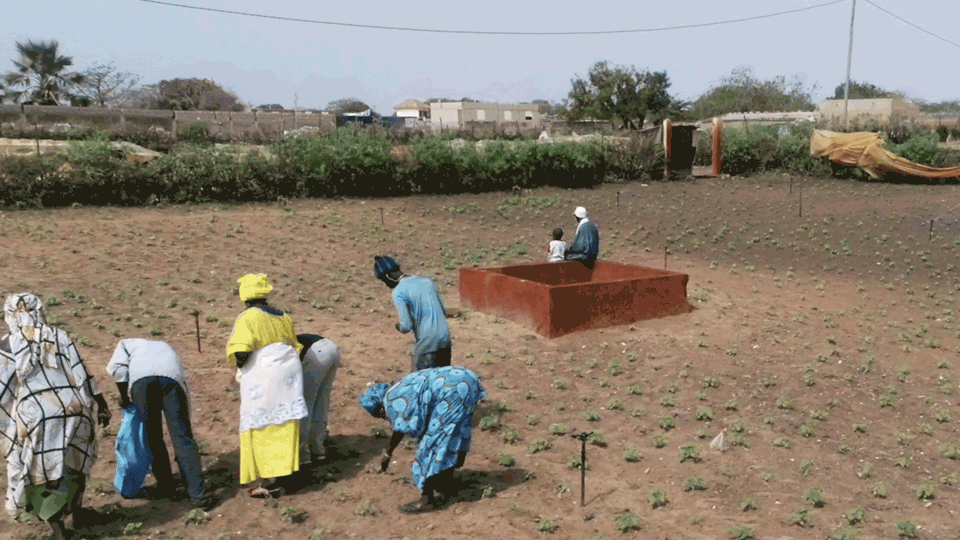
Publications and Presentations
Publications
Agyin-Birikorang, S., I. Tindjina, A.R.A. Fuseini, H.W. Dauda, and R.A. Issahaku, U. Singh. 2020. “Application Timing of Urea Supergranules for Climate-Resilient Maize Cultivars Grown in Northern Ghana,” Journal of Plant Nutrition, 43:7, 949-964. https://doi.org/10.1080/01904167.2019.1702207
Agyin-Birikorang, S., I. Tindjina, C. Boubakary, W. Dogbe, and U. Singh. 2020. “Resilient Rice Fertilization Strategy for Submergence-Prone Savanna Agro-Ecological Zones of Northern Ghana,” Journal of Plant Nutrition, 43:7, 965-986, https://doi.org/10.1080/01904167.2019.1702209
Agyin-Birikorang, S., I. Tindjina, R. Adu-Gyamfi, H.W. Dauda, A.R.A. Fuseini, and U. Singh. 2020. “Agronomic Effectiveness of Urea Deep Placement Technology for Upland Maize Production.” Nutrient Cycling in Agroecosyst, 116:179-193. https://doi.org/10.1007/s10705-019-10039-8
Aremu, T., C.Y. Freeman, A. Laamari, Y. Iddrisu, W.K. Atakora, and P.S. Bindraban. 2020. “Toward Establishing a Ghana Multi-Stakeholder Fertilizer Platform: Insights from Stakeholder and Network Analysis,” IFDC FERARI Policy Brief 1. https://ifdc.soutronglobal.net/Library/Catalogues/Controls/Download.aspx?id=606
Anderson, J.R., L. Nagarajan, A. Naseem, C. Pray, and T.A. Reardon. 2020. “New Corona Virus, Food Security and Identifying Policy Options.” Wieś i Rolnictwo, 4(189):77-88. https://doi.org/10.7366/wir042020/05
Baral, B., K. Pande, Y. Gaihre, K. Baral, S. Sah, and Y. Thapa. 2020. “Farmers’ Fertilizer Application Gap in Rice-Based Cropping System: A Case Study of Nepal,” SAARC Journal of Agriculture, 17(2):267-277. https://doi.org/10.3329/sja.v17i2.45311
Baral, B., K. Pande, Y. Gaihre, K. Baral, S. Sah, Y. Thapa, and U. Singh. 2020. “Increasing Nitrogen Use Efficiency in Rice Through Fertilizer Application Method Under Rainfed Drought Conditions in Nepal,” Nutrient Cycling in Agroecosystems, 118:103-114. https://doi.org/10.1007/s10705-020-10086-6
Bationo, A., U. Singh, E. Dossa, J. Wendt, S. Agyin-Birikorang, F. Lompo, and P. Bindraban. 2020. “Improving Soil Fertility through Fertilizer Management in Sub-Saharan Africa,” IN Soil and Fertilizers: Managing the Environmental Footprint, Rattan Lal (Ed.), pp. 67‑102, CRC Press.
Bindraban, P.S., C.O. Dimkpa, and R. Pandey. 2020. “Exploring Phosphorus Fertilizers and Fertilization Strategies for Improved Human and Environmental Health,” Biology and Fertility of Soils, 56:299-317. https://doi.org/10.1007/s00374-019-01430-2
Bindraban, P.S., C.O. Dimkpa, J.C. White, F.A. Franklin, A. Melse-Boonstra, N. Koele, R. Pandey, J. Rodenburg, K. Senthilkumar, P. Demokritou, and S. Schmidt. 2020. “Safeguarding Human and Planetary Health Demands a Fertilizer Sector Transformation,” Plants, People, Planet, 2:302-309. https://doi.org/10.1002/ppp3.10098
Bua, S., K. El Mejahed, D. MacCarthy, D.S. Adogoba, I.N. Kissiedu, W.K. Atakora, M. Fosu, and P.S. Bindraban. 2020. “Yield Responses of Maize to Fertilizers in Ghana,” IFDC FERARI Policy Brief No. 2. https://ifdc.soutronglobal.net/Library/Catalogues/Controls/Download.aspx?id=607
Das, S., M. Jahiruddin, M.R. Islam, A. Al Mahmud, A. Hossain, and A.M. Laing. 2020. “Zinc Biofortification in the Grains of Two Wheat (Triticum aestivum L.) Varieties Through Fertilization,” Acta Agrobotanica, 73(1):7312. https://doi.org/10.5586/aa.7312
Dhakal, K., B. Baral, K. Pokhrel, N. Pandit, S. Thapa, Y. Gaihre, and S.P. Vista. 2020. “Deep Placement of Briquetted Urea Increases Agronomic and Economic Efficiency of Maize in Sandy Load Soil,” AGRIVITA, Journal of Agricultural Science, 42(3):499-508. http://doi.org/10.17503/agrivita.v42i3.2766
Dimkpa, C.O., J. Fugice, U. Singh, and T.D. Lewis. 2020. “Development of Fertilizers for Enhanced Nitrogen Use Efficiency–Trends and Perspectives.” Science of the Total Environment, 731:139113. https://doi.org/10.1016/j.scitotenv.2020.139113
Dimpka, C.O., J. Andrews, J. Fugice, U. Singh, P.S. Bindraban, W.H. Elmer, J.L. Gardea-Torresdey, and J.C. White. 2020. “Facile Coating of Urea with Low-Dose ZnO Nanoparticles Promotes Wheat Performance and Enhances Zn Uptake Under Drought Stress,” Frontiers in Plant Science, 11. https://doi.org/10.3389/fpls.2020.00168
Dimpka, C.O., J. Andrews, J. Sanabria, P.S. Bindraban, U. Singh, W.H. Elmer, J.L. Gardea-Torresdey, and J.C. White. 2020. “Interactive Effects of Drought, Organic Fertilizer, and Zinc Oxide Nanoscale and Bulk Particles on Wheat Performance and Grain Nutrient Accumulation,” Science of the Total Environment, 722:137808. https://doi.org/10.1016/j.scitotenv.2020.137808
Falconnier, G.N., M. Corbeels, K. Boote, F. Affholder, M. Adam, D.S. MacCarthy, A.C. Ruane, C. Nendel, A.M. Whitbread, G. Hoogenboom, U. Singh, W.N. Smith, A. Srivastava, S. Sinha, F. Tao, P.J. Thorburn, D. Timlin, B. Traore, T. Twine, and H. Webber. 2020. “Modelling Climate Change Impacts on Maize Yields Under Low Nitrogen Input Conditions in Sub-Saharan Africa,” Global Change Biology, 26(10):5942-5964. https://doi.org/10.1111/gcb.15261
Gaihre, Y., U. Singh, W. Bible, J. Fugice, and J. Sanabria. 2020. “Mitigating N2O and NO Emissions from Direct-Seeded Rice with Nitrification Inhibitor and Urea Deep Placement,” Rice Science, 27(5):434-444. https://doi.org/10.1016/j.rsci.2020.03.005
Gao, Y., D. Wallach, B. Liu, M. Dingkuhn, K.J. Boote, U. Singh, S. Asseng, T. Kahveci, J. He, R. Zhang, R. Confalonieri, and G. Hoogenboom. 2020. “Comparison of Three Calibration Methods for Modeling Rice Phenology,” Agricultural and Forest Meteorology, 280:107785. https://doi.org/10.1016/j.agrformet.2019.107785
Iddrisu, Y., T.B. Aremu, W.K. Atakora, R. Wheeler, P. Annequin, F. Gyasi, C.Y. Freeman, and P.S. Bindraban. 2020. “Stakeholders in Ghana Discuss How a National Fertilizer Platform Could Address Fertilizer Sector Issue,” IFDC FERARI Policy Brief No. 3. https://ifdc.soutronglobal.net/Library/Catalogues/Controls/Download.aspx?id=608
Inamahoro, M., E. Vyizigiro, A. Bararyenya , E. Hakizimana, P. Niyonzima, D. Nyawakira, and G. Buhanza. 2020. Effect of Gibberellic Acid and Super Gro Foliar Fertilizer on Potato Tuber Sprouting in Diffused Light, Pit and Bulk Storage Conditions, PSSD project, ISABU and IFDC. https://ifdc.soutronglobal.net/Library/Catalogues/Controls/Download.aspx?id=602
Islam, S.M.M., Y. Gaihre, M.R. Islam, M. Akter, A. Al Mahmud, U. Singh, and B.O. Sander. 2020. “Effect of Water Management on Greenhouse Gas Emissions from Farmers’ Rice Fields in Bangladesh,” Science of the Total Environment, 734:139382. https://doi.org/10.1016/j.scitotenv.2020.139382
Malhotra, H., R. Pandey, S. Sharma, and P.S. Bindraban. 2020. “Foliar Fertilization: Possible Routes of Iron Transport from Leaf Surface to Cell Organelles,” Archives of Agronomy and Soil Science, 66:3, 279-300, https://doi.org/10.1080/03650340.2019.1616288
Nagarajan, L., A. Naseem, and C.E. Pray. 2020. “Seed Policy Reforms in Zambia,” Agrilinks, March 9, 2020. https://www.agrilinks.org/post/seed-policy-reforms-zambia
Odionye, N., S. Dittoh, A. Laamari, W. Adzawla, K. Idongesit, E. Afimia, W.K. Atakora, M. Jemo, and P.S. Bindraban. 2020. “Cost Components in the Fertilizer Value Chain and Implications for Accessibility by Farmers in Ghana,” IFDC FERARI Policy Brief No. 4.
PAPAB. 2020. Protocole de production des semences de pomme de terre, PAPAB project. https://ifdc.soutronglobal.net/Library/Catalogues/Controls/Download.aspx?id=603
Parihar, C.M., A. Singh, S. Jat, A. Dey, H. Nayak, B. Mandal, Y. Saharawat, M. Jat, and O.P. Yadav. 2020. “Soil Quality and Carbon Sequestration Under Conservation Agriculture with Balanced Nutrition in Intensive Cereal-Based System,” Soil and Tillage Research, 202:104653. https://doi.org/10.1016/j.still.2020.104653
Parihar, C.M., A.K Singh, and Y.S. Saharawat. 2020. Introductory Agronomy. Agrotech Publishing Academy, Udaipur, India.
Parihar, C.M., A.K. Singh, and Y.S. Saharawat. 2020. Introduction of Major Field Crops (textbook series). Agrotech Publishing Academy, Udaipur, India.
Perondi, D., C. Fraisse, M.M. Dewdney, V.A. Cerbaro, J.H.D. Andreis, A.B. Gama, G.J. Silva Jr., L. Amorim, W. Pavan, and N. Peres. 2020. “Citrus Advisory System: A Web-Based Postbloom Fruit Drop Disease Alert System,” Computers and Electronics in Agriculture, 178:105781. https://doi.org/10.1016/j.compag.2020.105781
Pray, C.E., L. Nagarajan, A. Naseem, and J.R. Anderson. 2020. “Chapter 3: Investing in Innovation,” IN Harvesting Prosperity: Technology and Productivity Growth in Agriculture, pp. 95-146, K. Fuglie, M. Gautam, A. Goyal, and W. Maloney (Eds.), World Bank. https://openknowledge.worldbank.org/bitstream/handle/10986/32350/978146481393.pdf?sequence=6&isAllowed=y
Siddique, I.A., A. Al Mahmud, M. Hossain, M.R. Islam, Y. Gaihre, and U. Singh. 2020. “Movement and Retention of NH4-N in Wetland Rice Soils as Affected by Urea Application Methods,” Journal of Soil Science and Plant Nutrition, 20(2):589-597. https://doi.org/10.1007/s42729-019-00148-2
Singh, U. 2020. “Micronutrients’ Roles in Improving Crop Yields and the Effectiveness of Nanoscale Formulations.” IFA Fertilizers & Agriculture Newsletter: Micronutrients in Focus. https://www.fertilizer.org/Public/Media/In_Brief/Public/Media/In_Brief/2020_09_16_Micronutrients_Improving_Crop_Yields.aspx
Vyizigiro, E., M. Inamahoro, P. Niyonzima, D. Havyarimana, W.D. Emera, and A.M. Nsabimana. 2020. Enquête de diagnostic sur l’engouement des agriculteurs de la région de basse altitude par rapport à la culture de pomme de terre, PSSD project, ISABU. https://ifdc.soutronglobal.net/Library/Catalogues/Controls/Download.aspx?id=601
Wang, X., S. Liu, X. Yin, N. Bellaloui, J.H. Winings, S. Agyin-Birikorang, U. Singh, J. Sanabria, and A. Mengistu. 2020. “Maize Grain Composition with Additions of NPK Briquette and Organically Enhanced N Fertilizer.” Agronomy, 10:6. https://doi.org/10.3390/agronomy10060852
Wiest, R., J. Salvadori, J.M.C. Fernandes, D. Lau, W. Pavan, W. Zanini, J. Toebe, and A. Lazzaretti. 2020. “Population Growth of Rhopalosiphum Padi Under Different Thermal Regimes: An Agent‐Based Model Approach,” Agricultural and Forest Entomology. https://doi.org/10.1111/afe.12404
Zhang, S., Y. Yang, Z. Tong, B. Gao, N. Gao, T. Shen, Y. Wan, Z. Yu, L. Liu, X. Ma, Y. Guo, J. Fugice, and Y. Li. 2020. “Self-Assembly of Hydrophobic and Self-Healing Bio- Nanocomposite-Coated Controlled-Release Fertilizer.” ACS Applied Materials & Interfaces.
Presentations
Bindraban, P.S., R. Pandey, C. Dimkpa, and W.K. Atakora. 2020. “Adapting Agriculture to Degrading Soils and Changing Climate in Africa,” presented at the International Conference on Phosphates (ICP): Fundamentals, Processes, Technologies, October 13-17, 2020, Ben Guerir, Morocco.
Bindraban, P.S., et al. 2020. “Balanced Nutrition Improves Plant Health and Protection,” panel abstract submitted to 2020 Plant Health, Agriculture and Bioscience Conference, September 9-11, 2020, The Hague, The Netherlands.
Demiss, Mulugeta. 2020. “Developing Teff Model in DSSAT and Teff’s Response to Different Growth Factors Study,” IFDC Webinar, February 11, 2020, Muscle Shoals, Alabama.
Dimkpa, C., P. Bindraban, W. Elmer, and J. White. 2020. “Fertilizer-Nutrients for Sustaining Plant Health Under Drought Stress,” abstract submitted to 2020 Plant Health, Agriculture and Bioscience Conference, September 9-11, 2020, The Hague, The Netherlands.
Saharawat, Y.S. 2020. “Climate Smart Nutrient Management and Role of Youth in Doubling Farmers Income,” presented at a one-week training program on Secondary Agriculture for Doubling Farmers Income: Using Efficient Technologies conducted by National Agriculture High Education Program and Indian Council of Agricultural Research at SKUAST Kashmir, India on October 5, 2020.
Singh, U. 2020. “Role of Micronutrients in Improving Climatic Resilience and Future Research Areas for Improving Use Efficiency,” IFA Webinar on Improving Human Health with Micronutrient Fertilization, October 26, 2020. https://www.youtube.com/watch?v=dBk2v0hdJnI.
Singh, U. 2020. “The Role of Nanotechnology in Enhancing Efficiency of Fertilizers,” presented at Materials Innovation for Sustainable Agriculture (MISA) 2020, Scientific Program organized by MISA and NanoScience Technology Center, University of Central Florida. November 12, 2020.
Singh, U. “Improving Yield and Nutrition through Fertilizer Formulation and Management,” presented during the session on Fertilizer Strategies in Improving Micronutrient Status of Food Crops at the Micronutrient Forum (MNF) Conference, November 9-13, 2020.
Stewart, Z.P. 2020. “Market Place: Introduction to the SOILS Consortium. Supporting Soil Health Interventions in Ethiopia: Opportunities for Accelerating Impact,” Gates, GIZ, EIAR, February 6-7, 2020, Addis Ababa, Ethiopia.
Wendt, J. 2020. “Determining Lime Requirement,” presented at a workshop hosted by KeFERT on lime impact study dissemination workshop of Kenya Markets Trust (KMT), January 5, 2020, Nairobi, Kenya.
Financial Statement
The following is a summary of financial information for the year ended December 31, 2020. The full financial statements and the independent auditors’ reports are available from IFDC upon request. IFDC’s Audited Financial Statements are available online at this page.
Statement of Revenue & Expenses for the Year Ended December 31, 2020
| Revenues & Gains | 2020 (U.S. $’000) | 2019 (U.S. $’000) |
|---|---|---|
| Alliance for a Green Revolution in Africa | 898 | 1,693 |
| African Fertilizer and Agribusiness Partnership (AFAP) | – | 9 |
| African Development Bank | 281 | 833 |
| Board of Directors Donations | 41 | – |
| Dutch Embassies | 18,102 | 18,531 |
| International Fertilizer Association | 167 | 151 |
| Islamic Development Bank | 674 | 766 |
| Embassy of Ireland (Irish Aid) | 402 | 434 |
| Millennium Challenge Account (MCA) | 690 | 1,599 |
| Netherlands Ministry for Development Cooperation (DGIS) | 13,304 | 8,341 |
| OCP Foundation | 2,044 | – |
| Swiss Agency for Development and Cooperation (SDC) | 571 | 199 |
| United Nations Office for Project Services (UNOPS-LIFT) | 941 | 1,351 |
| U.S. Agency for International Development | 8,620 | 9,310 |
| Walmart Foundation, Inc. | 290 | 132 |
| Others | 3,579 | 4,446 |
| Total Revenues & Gains | 50,604 | 47,795 |
| Expenses | 2020 (U.S. $’000) | 2019 (U.S. $’000) |
|---|---|---|
| Research and development | 3,416 | 3,602 |
| Field projects | 36,331 | 35,716 |
| Capacity building | 3,256 | 2,710 |
| Support activities | 5,491 | 5,460 |
| Total Expenses | 48,494 | 47,470 |
| Surplus/(loss) | 2,110 | 316 |
Balance Sheet for the Year Ended December 31, 2020
| 2020 (U.S. $’000) | 2019 (U.S. $’000) | |
|---|---|---|
| Total assets | 29,665 | 26,737 |
| Total liabilities | 30,038 | 29,232 |
| Unrestricted net assets | (373) | (2,495) |
| Total Liabilities and Net Assets | 29,665 | 26,737 |
Expenses by Function for the Year Ended December 31, 2020
| Function | 2020 (U.S. $’000) | 2019 (U.S. $’000) |
|---|---|---|
| Personnel | 20,596 | 20,605 |
| Travel | 1,744 | 3,750 |
| Operations | 4,559 | 4,349 |
| Workshops & training | 3,242 | 4,066 |
| Equipment & supplies | 2,422 | 2,422 |
| Subcontracts & grants | 15,931 | 12,287 |
| Total Expenses | 48,494 | 47,479 |
IFDC Board of Directors Contributes to Infrastructure Fund
An anonymous pledge of U.S. $25,000 was offered in 2020 to contribute to IFDC’s infrastructure needs at its headquarters. The donation was contingent upon at least a 2:1 match ratio by the IFDC Board of Directors and others. Thanks to the anonymous donor’s pledge and contributions from our board and others, IFDC’s infrastructure fund received nearly U.S. $100,000 in funding contributions in 2020 and 2021. These funds supported the replacement of roofs on all IFDC HQ buildings, which was completed in 2020 and 2021. Such and other donations will continue to further the capacity to deliver innovations at IFDC’s Muscle Shoals, AL headquarters.
Publication Credits
Contributors: Prem Bindraban, Masturah Chemisto, Anna Gongre, Julie Kohler, Matthew Miller, Latha Nagarajan, Mamadou Ouattara, Upendra Singh, Kasta Staggs, James Thigpen
Executive Editor: James Thigpen
Editor: Julie Kohler
Graphic Designer: Meg Ross
Online Layout: Anna Gongre and James Thigpen
Production Consultant: Donna Venable
Copyright © 2021 by IFDC. All Rights Reserved.
All photographs, unless otherwise noted, are from the IFDC photo archives.


